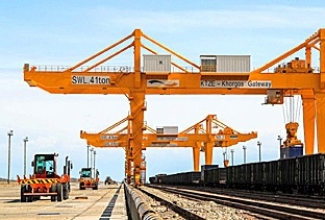Search Company:

A closer look at Beijing’s plans to expand an already extensive Central Asian network.
China is seeking to push its ambitious new Silk Road project with massive infrastructure measures. ITJ correspondent Manik Mehta has taken a closer look at Beijing’s plans to expand an already extensive Central Asian network.
China’s president Xi Jinping is going ahead with his country’s plans for a new Silk Road. The nation wants to use the ‘one belt, one road’ initiative to intensify the degree of globalisation of its economy, and to give its foreign trade new impulses. 29 heads of state and government gathered in Beijing in mid-May for the first official ‘one belt, one road’ summit, at which they sought to establish a framework for the rejuvenation of the east–west trade route.
The Chinese president shone in the international limelight, explaining that he hopes “to create is a big family of harmonious coexistence between nations.” He made an initial commitment to invest EUR 110 billion in railtracks, ports and the other infrastructure that trade along the new corridors will require. The idea is that whereas in the olden days silk, spices, tea, porcelain, gold and silver were traded along the ancient Silk Road, the future will see high-speed trains carrying high-tech freight, oil and gas pouring through pipelines, roads and ports linking companies and communities and special economic areas being set up as the new home of major enterprises.
The ‘one belt, one road’ project focuses on two routes – a maritime option through South Asia and Africa towards the Mediterranean; and an overland route through Central Asia to Central Europe. The countries located along these corridors will be supported economically, receive investments and also interlink their networks amongst each other. Many observers have criticised the lack of transparency ruling the plans and questioned Chinese banks’ loan conditions. “One belt, one road focuses less on investment and more on loans, which have to be repaid, together with interest, to the Chinese banks providing the funds”, according to the Mumbai-based logistics expert Arvind Desai. Indian concerns have addressed a planned Sino-Pakistani economic corridor in particular; it is supposed to pass through Kashmir, which is contested by the two neighbours.
Taking local sensitivities into account
In contrast, Chinese firms have not yet encountered any substantial problems in Central Asia. But major infrastructure projects always also include big challenges, especially when it comes to dwindling local resources – such as power, water and space for roads. If there is a local perception that the Chinese are being prioritised, then people may soon feel that they are being placed at a disadvantage.
For China itself, in turn, ‘one belt, one road’ is considered a growth engine and a means with which to restructure an imbalance between the well-developed east of the country and structurally weaker central and western areas. Thus Central Asia and the Chinese border region of Xinjiang play a strategic role in the project, which includes a dense network of roads and railway routes, oil and gas pipelines and other infrastructural measures from Xi’an in central China through Central Asia all the way to Europe. Beijing wants to make the most of new business opportunities; but it also wants to remain on the right side of the mainly Turkic populations in the Central Asian republics. Read more
Source: ITJ




